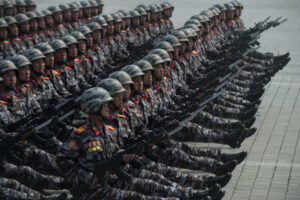When Trump returns to the White House next year, he’d be wise not to ignore one of the obsessions of his first term: North Korea. For while the Kim regime has been prodded from the news agenda over recent years, it still has the potential to cause trouble. That’s clear enough in Ukraine, where the DPRK has offered both men (about 10,000 troops) and materiel (over 15,000 containers) to Putin’s war effort.
And if the ultimate value of this support remains dubious — what North Korea is providing Russia pales in comparison to the over $175 billion worth of supplies Ukraine has received from Washington — it nonetheless speaks to the fact that the DPRK is one of the most militarised societies on earth. From an immense army, to an intensive if rickety arms industry, this is a country that can make its presence felt thousands of miles from its borders, especially once you factor in Kim Jong Un’s remarkable ability to circumvent sanctions and supply weapons to terrorists. Dovetail too the country’s long-running nuclear programme, and Trump must clearly take North Korea seriously, especially compared to the laxness of his predecessor.
In North Korean studies, one often hears of the country’s “military-first” policy or songun. This is the country’s stated policy of allocating as many state resources as possible to military development. In the event, songun is somewhat controversial, not actually appearing in writing until after nation-founder Kim Il Sung died in 1994. Yet it’s clear that the younger Kim believes his country needs to keep expanding its arsenal, both of conventional weapons and nuclear bombs. And if that explains why multiple rounds of diplomacy with the US and South Korea have failed — Kim never had any intention to denuclearise — the songun philosophy also speaks to recent domestic developments.
Right through Covid, for instance, Kim Jong Un only continued to double down on military development. Despite the rest of the world masking up and staying indoors, the country still held a lavish military parade in 2020 to mark the 75th anniversary of its Workers’ Party. The Korean People’s Army (KPA) is estimated to have over 1.3 million active personnel. Like its southern neighbour, military service is mandatory for all men, but women are also included via selective service. In theory, men must serve up to 10 years, and women eight, though the country’s richest elites are always finding ways to reduce their time through loopholes and bribes. This still makes North Korea one of the most militarised countries on earth and its people are instilled in warmaking from a very young age.
Channelling his father and grandfather, meanwhile, Kim has mobilised millions of young people to join the country’s army, even as North Korean children have “volunteered” to work in coal mines, farms, and factories. According to one defector, factory workers enjoy just one day off a week. Agricultural labourers have it even worse, getting only one day off in 10. Like most socialist countries, meanwhile, one’s own labour is framed by government propaganda as essential in furthering revolutionary state goals. While North Koreans are typically required to work eight hours a day at minimum, this can be stretched much further if issued quotas are not met. Children are also mobilised to participate in the workforce so they are instilled with a sense of loyalty toward the regime as early as possible.
Certainly, this mass conscription helps explain why the DPRK has managed to send Russia so much military equipment, even as far richer nations are struggling to meet the demand. Not that the West should look to North Korea for inspiration anytime soon. That’s clear enough ethically: UN reports have consistently shown that forced labour and abysmal working conditions are rampant across the DPRK. More than that, though, the products of these sweatshops aren’t proving very useful. Experts assert that the DPRK’s munitions being found on the battlefields of Russia are highly unreliable, unsurprising given they come from old stocks.
That’s equally true when you look at specific weapons. Debris recently recovered from a crashed projectile appears to show that Russia is employing KN-23 or KN-24 missiles sent from North Korea. The KN-23 and KN-24 share similar hardware, which can make it difficult to distinguish which is which from wreckage. But, in theory, they can strike targets from 400 to 690 kilometres away and are particularly challenging to intercept. In practice, however, Ukraine’s forces were able to shoot one of these missiles down, while experts from NAKO, a Kyiv non-governmental organisation, believe it may have been faulty to begin with.
Not that the role of the DPRK’s military equipment should necessarily be underestimated. After all, a war of attrition like the one in Eastern Europe can be prolonged indefinitely as long as both sides have enough ammunition and weapons to keep it going. North Korea is also not alone in exporting weapons to Russia: Iran and Chinese firms are providing Putin with everything from missiles to components. As any kind of peace treaty between Russia and Ukraine looks extremely unlikely for the foreseeable future, these shipments will undoubtedly continue as the war enters its third year in February.
And while North Korea’s aid may not be cutting-edge, the bigger question here is how it actually gets to Eastern Europe — especially given the mountain of foreign sanctions theoretically there to cripple the Kim regime. Things are especially given NAKO found that electronic components from the felled missile included parts from at least nine Western manufacturers, including ones based in the US and Britain. The chances of the West intentionally helping Pyongyang build weapons are obviously slim. Rather, it speaks to how deftly Kim has been able to sidestep outside sanctions.
The sanctions regime enacted by the United States and its allies has thus far been one of the most important tools for stopping North Korea’s illegal activities. But that hardly means it’s foolproof. As Mads Brügger has shown, officials in countries like Uganda are willing to look the other way if North Korean investment projects can benefit them. That’s even as shell companies can be used as fronts. Certainly, Kim Jong Un’s growing collection of luxury goods has still continued despite the pandemic. North Korea is also infamous for ship-to-ship transfers, which allow it to acquire sanctioned goods by using decommissioned and rebranded vessels flying under different flags.
No less important, North Korea is now fashioning itself as an arms exporter far beyond Russia. Sanctions monitoring organisations have long known that Pyongyang regularly deals with the likes of Syria and Iran in selling them old weapons stock, while also exchanging technical information on how to develop new missiles. Long before the war in Ukraine, North Korea has been a longtime supporter of terrorist groups like Hezbollah. While it’s unclear whether Kim Jong Un himself truly cares either way about the territorial disputes between Israel and the Palestinians, or between Moscow and Kyiv, North Korean support for the West’s enemies clearly makes sense. Having suffered terribly due to its self-imposed isolation during the pandemic, Pyongyang needs all help it can get. If this means aiding international terrorism, then so be it.
At the same time, this feeds into the future of North Korea-Russia relations. As a permanent member of the UN Security Council, Moscow can continue vetoing all new sanctions proposed against Pyongyang, even as the North Koreans themselves keep developing new weapons — and deliver them to the West’s ideological rivals. The DPRK is continuing to test and improve its ICBM technology, which is technically capable of reaching American shores. Then there’s the nuclear elephant in the room. With the West’s hopes of denuclearisation little more than a pipe dream, Kim Jong Un’s biggest priority is being recognised as a legitimate nuclear power. No wonder the country has conducted six nuclear weapons tests since 2006. South Korea’s military intelligence has long warned that Pyongyang is poised to conduct a seventh at any time, but when this will happen remains to be seen.
All this might matter less if the US were taking this threat seriously. As it is, and notwithstanding some new sanctions, the Biden administration largely treated North Korea as a side issue compared with China or the Middle East. But given Trump was the first sitting president to hold a summit with a North Korean leader, could he coax Kim Jong Un back to the negotiating table? The chances are slim, unless both leaders know that they can come away with something substantial. And given Kim is now adamant that the DPRK will never give up its nuclear weapons, it seems that future talks will only be around arms control, if they even happen at all. Though given how much of a threat North Korea poses from Lebanon to Ukraine, that’d surely be a start.
Disclaimer
Some of the posts we share are controversial and we do not necessarily agree with them in the whole extend. Sometimes we agree with the content or part of it but we do not agree with the narration or language. Nevertheless we find them somehow interesting, valuable and/or informative or we share them, because we strongly believe in freedom of speech, free press and journalism. We strongly encourage you to have a critical approach to all the content, do your own research and analysis to build your own opinion.
We would be glad to have your feedback.
Source: UnHerd Read the original article here: https://unherd.com/



